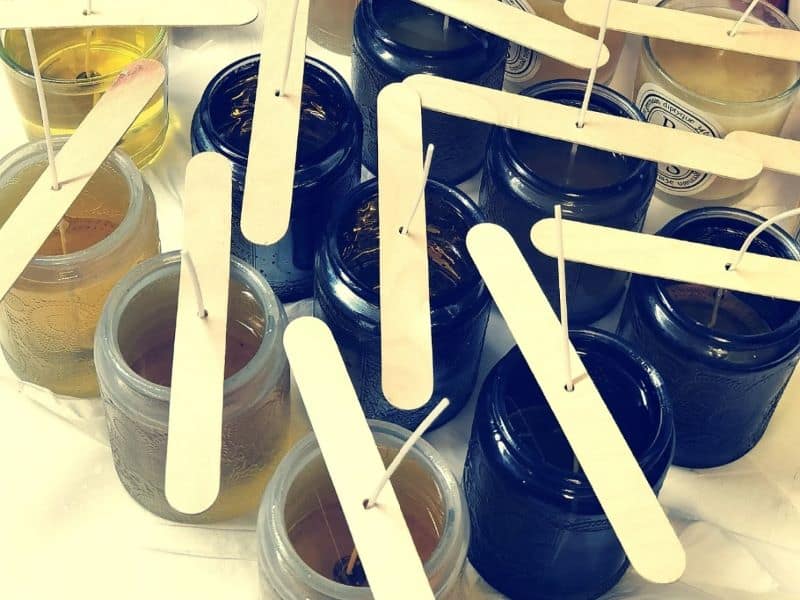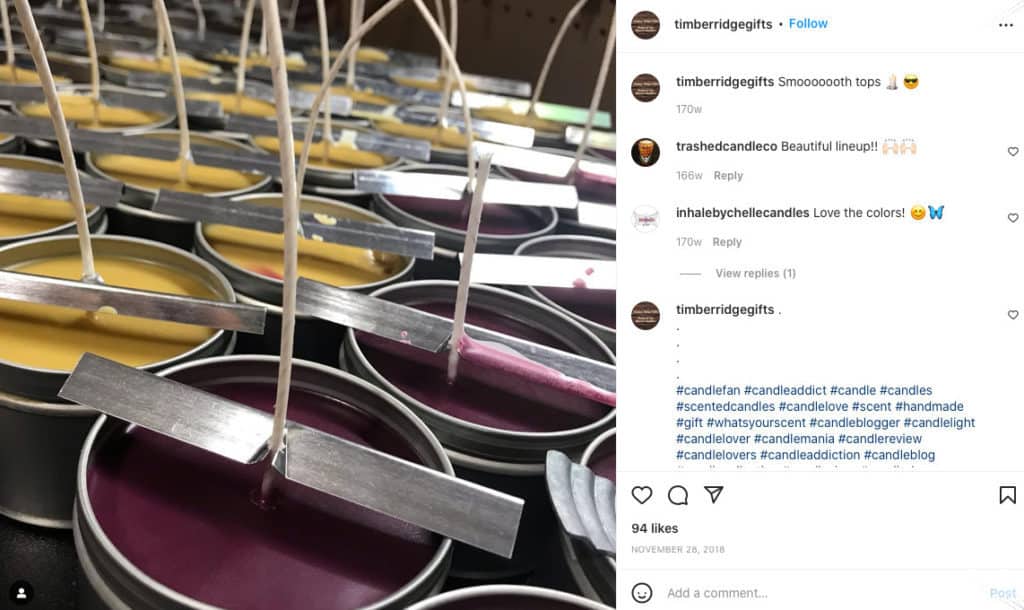There are a lot of different phases to candle making and curing is an important last step.
Broadly speaking, allowing a candle to cure helps in two ways. First, it lends time to fragrance oils that need to fully settle into wax molecules, which impacts your candle’s hot throw. If using softer waxes, like soy or coconut, the curing period also hardens the wax, which influences burn time performance.
Curing time varies by wax type and additional factors. If you stick around, I’ll share everything I understand about why candles need to be cured. Hint: to make quality candles, patience plays a huge role.

How Does Candle Curing Work?
Candle curing describes the chemical process that wax goes through as it cools and hardens. This process helps fragrance oils to properly join with wax molecules. In addition to fragrance distribution, curing gives softer wax candles more time to solidify, which aids in proper pooling.
By this explanation, it may seem that curing plays a direct role in fragrance strength, but this isn’t completely true.
While curing can strengthen the fragrance to a degree, the temperature of the wax when fragrance is added plays a bigger role in how strong a fragrance is in the end.
There’s a very detailed video out there that not only explains the process but supports the explanation with visual aids. It’s a little long, but it’s also the most down-to-earth yet comprehensive video that I found.
If you’re a candle maker, you’ll want to see this:
Timber Ridge Gifts no longer exists as a shop but there’s something to say about the ability to make soy candles with smooth tops and without condensation. This guy knows what he’s talking about.

Most people wonder if candles need to be cured because there’s no visible change in the candle after it’s cooled for 24 hours. But just because you can’t see the change, doesn’t mean it isn’t happening.
Curing occurs on a microscopic level, and unless you’re a chemist, you won’t be able to test the change in molecular structure.
Some people suggest that curing prevents candle sweating, but that’s not true.
Candle sweating, also called fragrance leeching, occurs when you either add too much fragrance oil to your wax, or the fragrance oil was added at too low a temperature. If the fragrance molecules aren’t properly bonded with the wax in the first place, curing won’t correct that.
Another cause for sweating is an abrupt change in temperature. So storing your candle in a cool, dry place can help prevent this.
Takeaway: Candles need to cure in order for fragrance oil molecules to bond with the molecular structure of your wax. But fragrance strength relies on multiple factors. Curing also helps vegetable wax candles to harden enough for appropriate burn performance.
What Happens If Candles Don’t Cure?
If you conduct a burn test on a candle that has not cured, you might get false results. Since the candle doesn’t completely harden for at least two days, burning it in less time than that can give you a misleading burn time. For vegetable waxes, it’s best to wait at least a week.
If you think about it, your customers won’t burn your candle right away. It’ll be days, likely weeks before they light it for the first time.
So testing your candle after a longer curing time will give you an indication of what your customers will experience. And you can make adjustments to the wick or jar size depending on the results.
A lot of candle cure testing that goes on online is with regards to scent – because that’s the only obvious difference. But I would suggest that you conduct your own test with the candle making supplies that you use. Do this at various time intervals in order to understand how your candles will work across a more realistic timeline
Your candles might even be more likely to tunnel if they aren’t properly cured.
This is because the center of the candle hasn’t completely hardened and will melt more quickly than the top did. An even cure can prevent this from happening.
Burn characteristics of plant based waxes change over time. If you want to offer quality candles to your customers that consistently burn well, it’s best not to rush the process.
Takeaway: If you light your candle too early, it may take less time to pool. This information might be misleading because the wax is still quite soft and will melt more quickly. Waiting a couple weeks can give you more accurate results.
Do All Types of Wax Require Curing?
All types of wax require curing but the length of time needed to cure varies. It varies by wax type, wick size, kind of fragrance used, and the size of the container or mold you’re using.
How Long Do Candles Need to Cure?
Unfortunately, there isn’t a straightforward answer to this question. The length of time a candle needs to cure depends on a lot of different factors. The biggest difference is the type of wax used.
How Long Do Paraffin Wax Candles Need to Cure?
Paraffin wax required the least amount of time to cure. Paraffin is more stable than vegetable waxes. And because it’s a harder wax, it can cure in two days. If it’s a large candle – very tall or wide – then I might longer. Wait five days to ensure that a paraffin wax candle has fully cured.
How Long Do Soy Wax Candles Need to Cure?
The chemical structure of soy wax is constantly changing. It is softer and needs much more time to cure than paraffin wax does. It’s reasonable to cure a soy candle for two weeks.
How Long Do Coconut Wax Candles Need to Cure?
Coconut wax is even softer than soy wax, which is why it’s often blended with soy or paraffin to make candles. If you’re using a coconut/soy wax blend, you can expect to cure it for at least two weeks. If your coconut wax is blended with paraffin wax, then a five day cure time is appropriate.
How Long Do Beeswax Wax Candles Need to Cure?
Beeswax takes at least one week to cure. Depending on other ingredients added, it might take up to two weeks to cure.
Takeaway: You will have to cure your candles no matter what kind of wax you use. If time is of the essence to you, you may want to use paraffin wax or a coconut/paraffin blend.
Final Thoughts
There is no doubt that candles need to be cured. But even if you follow manufacturer’s curing guidelines for a specific wax to fragrance ratio, there are a host of other factors, like interior temperature, where the candle is left to cool, and so forth that determines how well the candle will set.
All in all you have to test your candles across multiple time intervals, beginning at 48 hours. Two days is the least amount of time needed for paraffin wax candles to cure. Five days is the least amount of time needed for vegetable wax candles to cure.
Patience is key when creating exceptional gifts or products. So take your time, do testing, and try to keep conditions as consistent as possible.
Read more:
